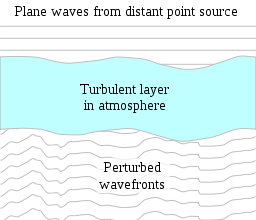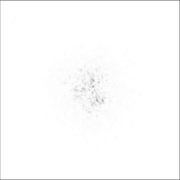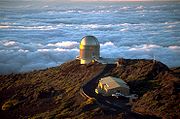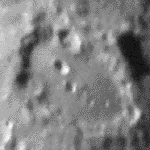
Astronomical seeing
Encyclopedia

Turbulence
In fluid dynamics, turbulence or turbulent flow is a flow regime characterized by chaotic and stochastic property changes. This includes low momentum diffusion, high momentum convection, and rapid variation of pressure and velocity in space and time...
in the Earth's atmosphere varying the optical refractive index
Refractive index
In optics the refractive index or index of refraction of a substance or medium is a measure of the speed of light in that medium. It is expressed as a ratio of the speed of light in vacuum relative to that in the considered medium....
. The astronomical seeing conditions on a given night at a given location describe how much the Earth's atmosphere perturbs the images of stars as seen through a telescope.
The most common seeing measurement is the diameter (technically full width at half maximum
Full width at half maximum
Full width at half maximum is an expression of the extent of a function, given by the difference between the two extreme values of the independent variable at which the dependent variable is equal to half of its maximum value....
or FWHM) of the seeing disc (the point spread function
Point spread function
The point spread function describes the response of an imaging system to a point source or point object. A more general term for the PSF is a system's impulse response, the PSF being the impulse response of a focused optical system. The PSF in many contexts can be thought of as the extended blob...
for imaging through the atmosphere). The point spread function diameter (seeing disc diameter or "seeing") is a reference to the best possible angular resolution
Angular resolution
Angular resolution, or spatial resolution, describes the ability of any image-forming device such as an optical or radio telescope, a microscope, a camera, or an eye, to distinguish small details of an object...
which can be achieved by an optical telescope
Optical telescope
An optical telescope is a telescope which is used to gather and focus light mainly from the visible part of the electromagnetic spectrum for directly viewing a magnified image for making a photograph, or collecting data through electronic image sensors....
in a long photographic exposure, and corresponds to the diameter of the fuzzy blob seen when observing a point-like star through the atmosphere. The size of the seeing disc is determined by the astronomical seeing conditions at the time of the observation. The best conditions give a seeing disk diameter of ~0.4 arcseconds
Minute of arc
A minute of arc, arcminute, or minute of angle , is a unit of angular measurement equal to one sixtieth of one degree. In turn, a second of arc or arcsecond is one sixtieth of one minute of arc....
and are found at high-altitude observatories on small islands such as Mauna Kea
Mauna Kea Observatory
The Observatories at Mauna Kea, , are an independent collection of astronomical research facilities located on the summit of Mauna Kea on the Big Island of Hawai'i, USA. The facilities are located in a special land use zone known as the "Astronomy Precinct," which is located in the Mauna Kea...
or La Palma
Roque de los Muchachos Observatory
Roque de los Muchachos Observatory is an astronomical observatory located in the municipality of Garafía on the island of La Palma in the Canary Islands...
.
Seeing is one of the biggest problems for Earth-based astronomy: while the big telescope
Telescope
A telescope is an instrument that aids in the observation of remote objects by collecting electromagnetic radiation . The first known practical telescopes were invented in the Netherlands at the beginning of the 1600s , using glass lenses...
s have theoretically milli-arcsecond resolution, the real image will never be better than the average seeing disc during the observation. This can easily mean a factor of 100 between the potential and practical resolution. Starting in the 1990s, new adaptive optics
Adaptive optics
Adaptive optics is a technology used to improve the performance of optical systems by reducing the effect of wavefront distortions. It is used in astronomical telescopes and laser communication systems to remove the effects of atmospheric distortion, and in retinal imaging systems to reduce the...
have been introduced that can help correct for these effects, dramatically improving the resolution of ground based telescopes.
The image fluctuations seen when looking at the bottom of a lake on a windy day are caused by refractive index fluctuations, but in the case of a lake they do not result from turbulent mixing.
The effects of astronomical seeing
Astronomical seeing has several effects:- It causes the images of point sourcePoint sourceA point source is a localised, relatively small source of something.Point source may also refer to:*Point source , a localised source of pollution**Point source water pollution, water pollution with a localized source...
s (such as stars), which in the absence of atmospheric turbulence would be steady Airy patterns produced by diffraction, to break up into speckle patterns, which change very rapidly with time (the resulting speckled images can be processed using speckle imagingSpeckle imagingSpeckle imaging describes a range of high-resolution astronomical imaging techniques based either on the shift-and-add method or on speckle interferometry methods...
) - Long exposure images of these changing speckle patterns result in a blurred image of the point source, called a seeing disc
- The brightness of stars appears to fluctuate in a process known as scintillationScintillation (astronomy)Scintillation or twinkling are generic terms for rapid variations in apparent brightness or color of a distant luminous object viewed through a medium, most commonly the atmosphere ....
or twinkling - Atmospheric seeing causes the fringes in an astronomical interferometerAstronomical interferometerAn astronomical interferometer is an array of telescopes or mirror segments acting together to probe structures with higher resolution by means of interferometry....
to move rapidly - The distribution of atmospheric seeing through the atmosphere (the CN2 profile described below) causes the image quality in adaptive opticsAdaptive opticsAdaptive optics is a technology used to improve the performance of optical systems by reducing the effect of wavefront distortions. It is used in astronomical telescopes and laser communication systems to remove the effects of atmospheric distortion, and in retinal imaging systems to reduce the...
systems to degrade the further you look from the location of reference star
The effects of atmospheric seeing were indirectly responsible for the belief that there were canals on Mars. In viewing a bright object such as Mars, occasionally a still patch of air will come in front of the planet, resulting in a brief moment of clarity. Before the use of charge-coupled device
Charge-coupled device
A charge-coupled device is a device for the movement of electrical charge, usually from within the device to an area where the charge can be manipulated, for example conversion into a digital value. This is achieved by "shifting" the signals between stages within the device one at a time...
s, there was no way of recording the image of the planet in the brief moment other than having the observer remember the image and draw it later. This had the effect of having the image of the planet be dependent on the observer's memory and preconceptions which led the belief that Mars had linear features.
The effects of atmospheric seeing are qualitatively similar throughout the visible and near infra-red wavebands. At large telescopes the long exposure image resolution is generally slightly higher at longer wavelengths, and the timescale (t0 - see below) for the changes in the dancing speckle patterns is substantially lower.
Measures of astronomical seeing
There are three common descriptions of the astronomical seeing conditions at an observatory:- The FWHM of the seeing disc
- r0 (the size of a typical "lump" of uniform air within the turbulent atmosphere) and t0 (the time-scale over which the changes in the turbulence become significant)
- The CN2 profile
These are described in the sub-sections below:
The full width at half maximum (FWHM) of the seeing disc
Without an atmosphere, a small star would have an apparent size, an "Airy disk", in a telescope image determined by diffractionDiffraction
Diffraction refers to various phenomena which occur when a wave encounters an obstacle. Italian scientist Francesco Maria Grimaldi coined the word "diffraction" and was the first to record accurate observations of the phenomenon in 1665...
and would be inversely proportional to the diameter of the telescope. However when light enters the Earth's atmosphere
Earth's atmosphere
The atmosphere of Earth is a layer of gases surrounding the planet Earth that is retained by Earth's gravity. The atmosphere protects life on Earth by absorbing ultraviolet solar radiation, warming the surface through heat retention , and reducing temperature extremes between day and night...
, the different temperature layers and different wind speeds distort the light waves leading to distortions in the image of a star. The effects of the atmosphere can be modeled as rotating cells of air moving turbulently. At most observatories the turbulence is only significant on scales larger than r0 (see below—the seeing parameter r0 is 10–20 cm at visible wavelengths under the best conditions) and this limits the resolution of telescopes to be about the same as given by a space-based 10–20 cm telescope.
The distortion changes at a high rate, typically more frequently than 100 times a second. In a typical astronomical image of a star with an exposure time of seconds or even minutes, the different distortions average out as a filled disc called the point spread function or "seeing disc". The diameter
Diameter
In geometry, a diameter of a circle is any straight line segment that passes through the center of the circle and whose endpoints are on the circle. The diameters are the longest chords of the circle...
of the seeing disk, most often defined as the full width at half maximum
Full width at half maximum
Full width at half maximum is an expression of the extent of a function, given by the difference between the two extreme values of the independent variable at which the dependent variable is equal to half of its maximum value....
(FWHM), is a measure of the astronomical seeing conditions.
It follows from this definition that seeing is always a variable quantity, different from place to place, from night to night and even variable on a scale of minutes. Astronomers often talk about "good" nights with a low average seeing disc diameter, and "bad" nights where the seeing diameter was so high that all observations were worthless.
The FWHM of the seeing disc (or just Seeing) is usually measured in arcseconds, abbreviated with the symbol ("). A 1.0" seeing is a good one for average astronomical sites. The seeing of an urban environment is usually much worse. Good seeing nights tend to be clear, cold nights without wind gusts. Warm air rises (convection
Convection
Convection is the movement of molecules within fluids and rheids. It cannot take place in solids, since neither bulk current flows nor significant diffusion can take place in solids....
) degrading the seeing as does wind and clouds. At the best high-altitude mountaintop observatories
Observatory
An observatory is a location used for observing terrestrial or celestial events. Astronomy, climatology/meteorology, geology, oceanography and volcanology are examples of disciplines for which observatories have been constructed...
the wind brings in stable air which has not previously been in contact with the ground, sometimes providing seeing as good as 0.4".
r0 and t0
The astronomical seeing conditions at an observatory can be well described by the parameters r0 and t0. For telescopes with diameters smaller than r0, the resolution of long-exposure images is determined primarily by diffraction and the size of the Airy pattern and thus is inversely proportional to the telescope diameter. For telescopes with diameters larger than r0, the image resolution determined primarily by the atmosphere and is independent of telescope diameter, remaining constant at the value given by a telescope of diameter equal to r0. r0 also corresponds to the length-scale over which the turbulence becomes significant (10–20 cm at visible wavelengths at good observatories), and t0 corresponds to the time-scale over which the changes in the turbulence become significant. r0 determines the spacing of the actuators needed in an active opticsActive optics
Active optics is a technology used with reflecting telescopes developed in the 1980s, which actively shapes a telescope's mirrors to prevent deformation due to external influences such as wind, temperature, mechanical stress...
system, and t0 determines the correction speed required to compensate for the effects of the atmosphere.
r0 and t0 vary with the wavelength used for the astronomical imaging, allowing slightly higher resolution imaging at longer wavelengths using large telescopes.
r0 is often known as the Fried parameter
Fried parameter
The Fried parameter or Fried's coherence length measures the optical quality of the atmosphere. This parameter is usually expressed in centimeters and corresponds to an area over which the rms wavefront aberration is less than 1 radian. As such, r_0 indicates the size of a telescope which can just...
, named after David L. Fried
David L. Fried
David L. Fried is a scientist, best known for his contributions to optics. Fried described what has come to be known as Fried's seeing diameter, or r0 . The seeing diameter is effectively a limiting aperture due to atmospheric turbulence, and is found either empirically or statistically. The...
.
Mathematical description of r0 and t0



 (defined below).
(defined below).  is a commonly used measurement of the astronomical seeing at observatories. At visible wavelengths,
is a commonly used measurement of the astronomical seeing at observatories. At visible wavelengths,  varies from 20 cm at the best locations to 5 cm at typical sea-level sites.
varies from 20 cm at the best locations to 5 cm at typical sea-level sites.In reality the pattern of blobs (speckles) in the images changes very rapidly, so that long exposure photographs would just show a single large blurred blob in the centre for each telescope diameter. The diameter (FWHM) of the large blurred blob in long exposure images is called the seeing disc diameter, and is independent of the telescope diameter used (as long as adaptive optics correction is not applied).
It is first useful to give a brief overview of the basic theory of optical
propagation through the atmosphere. In the standard classical theory,
light is treated as an oscillation in a field
 . For
. Formonochromatic plane waves arriving from a distant point source with
wave-vector
 :
:
where
 is the complex field at position
is the complex field at position  and
andtime
 , with real and imaginary parts corresponding to the electric
, with real and imaginary parts corresponding to the electricand magnetic field components,
 represents a phase offset,
represents a phase offset, is the frequency of the light determined by
is the frequency of the light determined by  , and
, and  is the
is theamplitude of the light.
The photon flux in this case is proportional to the square of the
amplitude
 , and the optical phase corresponds to the complex
, and the optical phase corresponds to the complexargument of
 . As wavefronts pass through the Earth's
. As wavefronts pass through the Earth'satmosphere they may be perturbed by refractive index variations in the
atmosphere. The diagram at the top-right of this page shows schematically a turbulent layer in the
Earth's atmosphere perturbing planar wavefronts before they enter a
telescope. The perturbed wavefront
 may be related at any
may be related at anygiven instant to the original planar wavefront
 in the following way:
in the following way:
where
 represents the fractional
represents the fractionalchange in wavefront amplitude and

is the change in wavefront phase introduced by the atmosphere. It is
important to emphasise that
 and
and describe the effect of the Earth's
describe the effect of the Earth'satmosphere, and the timescales for any changes in these functions will
be set by the speed of refractive index fluctuations in the atmosphere.
The Kolmogorov model of turbulence
A description of the nature of the wavefront perturbations introducedby the atmosphere is provided by the Kolmogorov model developed
by Tatarski, based partly on the studies of turbulence by the
Russian mathematician Andreï Kolmogorov
Andrey Kolmogorov
Andrey Nikolaevich Kolmogorov was a Soviet mathematician, preeminent in the 20th century, who advanced various scientific fields, among them probability theory, topology, intuitionistic logic, turbulence, classical mechanics and computational complexity.-Early life:Kolmogorov was born at Tambov...
. This model is supported by a variety of
experimental measurements and is widely used in
simulations of astronomical imaging. The model assumes that the
wavefront perturbations are brought about by variations in the
refractive index of the atmosphere. These refractive index variations
lead directly to phase fluctuations described by
 , but any amplitude fluctuations are only
, but any amplitude fluctuations are onlybrought about as a second-order effect while the perturbed wavefronts
propagate from the perturbing atmospheric layer to the telescope. For
all reasonable models of the Earth's atmosphere at optical and
infra-red wavelengths the instantaneous imaging performance is
dominated by the phase fluctuations
 . The amplitude fluctuations described by
. The amplitude fluctuations described by have negligible effect on the
have negligible effect on thestructure of the images seen in the focus of a large telescope.
For simplicity, the phase fluctuations in Tatarski's model are often assumed to have
a Gaussian random distribution with the following second order
structure function:

where
 is the
is theatmospherically induced variance between the phase at two parts of the
wavefront separated by a distance
 in the aperture
in the apertureplane, and
 represents the ensemble average.
represents the ensemble average.For the Gaussian random approximation, the structure function of Tatarski (1961) can be described in terms
of a single parameter
 :
:
 indicates the strength of the phase fluctuations as it
indicates the strength of the phase fluctuations as itcorresponds to the diameter of a circular telescope aperture at which
atmospheric phase perturbations begin to seriously limit the image
resolution. Typical
 values for I band (900 nm wavelength)
values for I band (900 nm wavelength)observations at good sites are 20---40 cm. It should be noted that
 also corresponds to the aperture
also corresponds to the aperturediameter for which the variance
 of the wavefront phase
of the wavefront phaseaveraged over the aperture comes approximately to unity:

This equation represents a commonly used definition for
 , a parameter frequently used to describe the atmospheric conditions at astronomical observatories.
, a parameter frequently used to describe the atmospheric conditions at astronomical observatories. can be determined from a measured CN2 profile (described below) as follows:
can be determined from a measured CN2 profile (described below) as follows:
where the turbulence strength
 varies as a function of height
varies as a function of height  above the telescope, and
above the telescope, and  is the angular distance of the astronomical source from the zenith
is the angular distance of the astronomical source from the zenithZenith
The zenith is an imaginary point directly "above" a particular location, on the imaginary celestial sphere. "Above" means in the vertical direction opposite to the apparent gravitational force at that location. The opposite direction, i.e...
(from directly overhead).
If turbulent evolution is assumed to occur on slow timescales, then the timescale t0 is simply proportional to r0 divided by the mean wind speed.
The refractive index fluctuations caused by Gaussian random turbulence can be simulated using the following algorithm:

where
 is the optical phase error introduced by atmospheric turbulence, R (k) is a 2 dimensional square array of independent random complex numbers which have a Gaussian
is the optical phase error introduced by atmospheric turbulence, R (k) is a 2 dimensional square array of independent random complex numbers which have a Gaussiandistribution about zero and white noise spectrum, K (k) is the (real) Fourier amplitude expected from the
Kolmogorov (or Von Karman) spectrum, Re[] represents taking the real part, and FT[] represents a discrete
Fourier transform of the resulting 2 dimensional square array (typically an FFT).

Turbulent intermittency
The assumption that the phase fluctuations in Tatarski's model havea Gaussian random distribution is usually unrealistic. In reality turbulence exhibits intermittency
These fluctuations in the turbulence strength can be straightforwardly simulated as follows::

where I (k) is a 2 dimensional array which represents the spectrum of intermittency, with the same dimensions
as R (k), and where
 represents convolution. The intermittency is described in terms of fluctuations in the
represents convolution. The intermittency is described in terms of fluctuations in theturbulence strength
 . It can be seen the equation for the Gaussian random case above is just the special case from this equation with:
. It can be seen the equation for the Gaussian random case above is just the special case from this equation with:
where
 is the Dirac delta function
is the Dirac delta functionDirac delta function
The Dirac delta function, or δ function, is a generalized function depending on a real parameter such that it is zero for all values of the parameter except when the parameter is zero, and its integral over the parameter from −∞ to ∞ is equal to one. It was introduced by theoretical...
.
The  profile
profile
A more thorough description of the astronomical seeing at an observatory is given by producing a profile of the turbulence strength as a function of altitude, called a  profile.
profile.  profiles are generally performed when deciding on the type of adaptive optics system which will be needed at a particular telescope, or in deciding whether or not a particular location would be a good site for setting up a new astronomical observatory. Typically, several methods are used simultaneously for measuring the
profiles are generally performed when deciding on the type of adaptive optics system which will be needed at a particular telescope, or in deciding whether or not a particular location would be a good site for setting up a new astronomical observatory. Typically, several methods are used simultaneously for measuring the  profile and then compared. Some of the most common methods include:
profile and then compared. Some of the most common methods include:
- SCIDAR (imaging the shadow patterns in the scintillation of starlight)
- LOLAS (a small aperture variant of SCIDAR designed for low-altitude profiling)
- SLODAR
- MASS
- RADAR mapping of turbulence
- Balloon-borne thermometers to measure how quickly the air temperature is fluctuating with time due to turbulence
There are also mathematical functions describing the
 profile. Some are empirical fits from measured data and others attempt to incorporate elements of theory. One common model for continental land masses is known as Hufnagel-Valley after two workers in this subject.
profile. Some are empirical fits from measured data and others attempt to incorporate elements of theory. One common model for continental land masses is known as Hufnagel-Valley after two workers in this subject.Overcoming atmospheric seeing

Speckle imaging
Speckle imaging describes a range of high-resolution astronomical imaging techniques based either on the shift-and-add method or on speckle interferometry methods...
, which allowed bright objects to be observed with very high resolution. Later came NASA
NASA
The National Aeronautics and Space Administration is the agency of the United States government that is responsible for the nation's civilian space program and for aeronautics and aerospace research...
's Hubble Space Telescope
Hubble Space Telescope
The Hubble Space Telescope is a space telescope that was carried into orbit by a Space Shuttle in 1990 and remains in operation. A 2.4 meter aperture telescope in low Earth orbit, Hubble's four main instruments observe in the near ultraviolet, visible, and near infrared...
, working outside the atmosphere and thus not having any seeing problems and allowing observations of faint targets for the first time (although with poorer resolution than speckle observations of bright sources from ground-based telescopes because of Hubble's smaller telescope diameter). The highest resolution visible and infrared images currently come from imaging optical interferometer
Astronomical interferometer
An astronomical interferometer is an array of telescopes or mirror segments acting together to probe structures with higher resolution by means of interferometry....
s such as the Navy Prototype Optical Interferometer
Navy Prototype Optical Interferometer
The Navy Prototype Optical Interferometer , is an astronomical interferometer operated by the United States Naval Observatory Flagstaff Station, in collaboration with the Naval Research Laboratory and The Lowell Observatory...
or Cambridge Optical Aperture Synthesis Telescope
Cambridge Optical Aperture Synthesis Telescope
COAST, the Cambridge Optical Aperture Synthesis Telescope, is a multi-element optical astronomical interferometer with baselines of up to 100 metres, which uses aperture synthesis to observe stars with angular resolution as high as one thousandth of one arcsecond COAST, the Cambridge Optical...
.
Starting in the 1990s, many telescopes have begun to develop adaptive optics
Adaptive optics
Adaptive optics is a technology used to improve the performance of optical systems by reducing the effect of wavefront distortions. It is used in astronomical telescopes and laser communication systems to remove the effects of atmospheric distortion, and in retinal imaging systems to reduce the...
systems that partially solve the seeing problem, but none of the systems so far built or designed completely removes the atmosphere effect, and observations are usually limited to a small region of the sky surrounding relatively bright stars.
Another cheaper technique, lucky imaging
Lucky imaging
Lucky imaging is one form of speckle imaging used for astronomical photography. Speckle imaging techniques use a high-speed camera with exposure times short enough so that the changes in the Earth's atmosphere during the exposure are minimal.With lucky imaging, those optimum exposures least...
, has had very good results. This idea dates back to pre-war naked-eye observations of moments of good seeing, which were followed by observations of the planets on cine film after World War II
World War II
World War II, or the Second World War , was a global conflict lasting from 1939 to 1945, involving most of the world's nations—including all of the great powers—eventually forming two opposing military alliances: the Allies and the Axis...
. The technique relies on the fact that every so often the effects of the atmosphere will be negligible, and hence by recording large numbers of images in real-time, a 'lucky' excellent image can be picked out. This technique can outperform adaptive optics in many cases and is even accessible to amateurs. It does, however, require very much longer observation times than adaptive optics
Adaptive optics
Adaptive optics is a technology used to improve the performance of optical systems by reducing the effect of wavefront distortions. It is used in astronomical telescopes and laser communication systems to remove the effects of atmospheric distortion, and in retinal imaging systems to reduce the...
for imaging faint targets, and is limited in its maximum resolution.
See also
- The Royal Astronomical Society of Canada Calgary Centre - Atmospheric "Seeing". Includes animated illustrations of effects of seeing.
- Atmosphere and Telescope SimulatorAtmosphere and Telescope SimulatorAtmosphere and Telescope Simulators are used because time in science-worthy class telescopes is generally expensive and difficult to obtain. Furthermore, telescope facilities are often uncomfortable for operators working on site long periods of time...
- Atmospheric turbulence simulator. - Clear Sky ChartClear Sky ChartClear Sky Charts are web graphics which deliver weather forecasts designed specifically for astronomers.They forecast the cloud cover, transparency and astronomical seeing, parameters which are not forecast by civil or aviation forecasts. They forecast hourly data, but are limited to forecasting...
- includes a weather forecast of astronomical seeing. - MirageMirageA mirage is a naturally occurring optical phenomenon in which light rays are bent to produce a displaced image of distant objects or the sky. The word comes to English via the French mirage, from the Latin mirare, meaning "to look at, to wonder at"...
- Transient lunar phenomenonTransient lunar phenomenonA transient lunar phenomenon , or lunar transient phenomenon , is a short-lived light, color, or change in appearance on the lunar surface....

